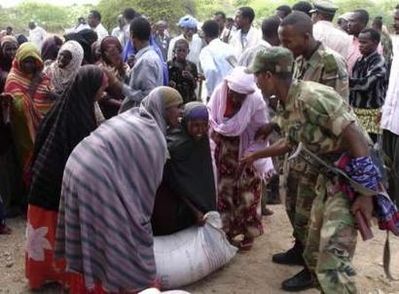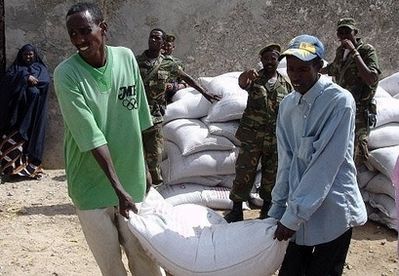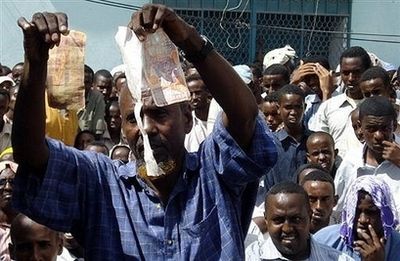|
More than 2.6 million Somalis in
crisis.
(Somalia, May 19,
2008 Ceegaag Online)

Situation could worsen, particularly for urban poor and
drought-hit rural communities, the humanitarian situation in
Somalia is deteriorating quickly due to soaring food prices,
a significantly devalued Somali shilling, and worsening
drought, FAO said today. More than 2.6 million people, or 35
percent of the total population, are in need of assistance –
an increase of more than 40 percent since January of this
year.
The increase in needs is due mainly to the addition of
600 000 urban poor, who are struggling to meet their
household food needs in the face of rapidly increasing food
and basic commodity prices, according to a recent assessment
of FAO’s Food Security Analysis Unit (FSAU) for Somalia.
The number of internally displaced people from Mogadishu,
the capital, has also increased – by over 20 percent since
January – and is now at 855 000 people, bringing the total
number of IDPs in the country to over 1 million.

Drought deepens
Compounding the problem is a worsening drought in parts of
south and central Somalia, as well as a deterioration of
rangeland conditions in areas in the north due to an
abnormally harsh dry season. The delayed and poor
performance of the ‘Gu’ seasonal rains that usually fall
from mid-April to June point to a well below normal main
cereal harvest, which will lead to shortages and further
price increases in locally produced cereals.
Around 60 000 pastoralists, already struggling to cope with
two consecutive seasons of rain failure, are in acute food
and livelihood crisis.
Half of population could be at risk
“If the Gu rains are significantly below normal, the
shilling continues to lose value, food prices increase
further and civil insecurity worsens, we could see as many
as 3.5 million people, or half the total population, facing
acute food and livelihood crisis or humanitarian emergency
conditions by the end of the year,” said Cindy Holleman,
FAO’s Chief Technical Adviser for Somalia. “It’s an
extremely worrying situation.”
Contingency planning and preparations need to begin now to
ensure a timely and appropriate response should this worst
case scenario come to pass, she said.

Record high cereal prices
Cereal prices of both commercial rice imports and locally
produced maize and sorghum, which have increased by as much
as 375 percent in some areas in the last year, are at
historic levels, two to three times higher than their
five-year average price.
Somalia is a net importer of cereals, with about 60 percent
of its food needs covered by imported cereals in a normal
year. Record high international food prices combined with
the sharp devaluation of the Somali shilling of more than
125 percent against the US dollar in the last four months
means that prices for imported cereals in Somalia will
remain at record highs and beyond the reach of most poor
urban households.
The urban poor are cutting down on the amounts of food they
buy, switching from imported rice to cheaper, locally
produced sorghum, which will itself be in short supply if
the Gu season fails, skipping meals, and reducing non-food
expenditures on items such as soap, kerosene, medicines and
schooling.
“Despite all these coping strategies, many poor urban
households do not have enough money to meet their basic
needs, with shortfalls ranging between 10-30 percent of the
total cost,” says Holleman.

Insecurity hinders humanitarian access
Concrete actions are needed to ensure that humanitarian
organizations have safe access to areas in crisis, FAO says,
noting that it is becoming increasingly dangerous for
humanitarian actors at a time of greatest need.
Still, there are many opportunities for rehabilitation and
recovery, according to Graham Farmer, who heads FAO’s
Somalia operations from offices in Nairobi.
“The security situation is constraining and frustrating, but
it hasn’t stopped us,” says Farmer, noting that the UN has
around 1 500 people working on Somalia, over half of whom
are in the country on any given day.
Emergency activities
FAO has taken a lead role in the coordination and monitoring
of humanitarian interventions in the agriculture sector.
The Food Security Analysis Unit for Somalia provides the
latest information on food security and nutrition as well as
early warning signals to allow better planning and response.
The FAO Emergency Coordination Unit in Somalia is
implementing an emergency and rehabilitation programme with
an overall budget of more than US$35 million for ongoing
projects to help rebuild food and livelihood security.
FAO’s activities include support to the livestock sector,
through the provision of veterinary services, surveillance
of animal health, and promotion of safety and quality
assurance practices for meat products; agricultural
rehabilitation and diversification, through the promotion of
integrated pest management practices, appropriate quality
seeds and rehabilitation of irrigation infrastructures;
assistance to fishing communities; and support to the
private sector, through micro-enterprises associated with
agricultural products, providing training and helping
establish market linkages.
Boosting production and incomes
“One can bring in food, but an important complementary
approach is to get money into these communities,” says
Farmer. “We need to boost not only production, but also
incomes and livelihoods in rural and peri-urban areas.”
Renovating irrigation canals, for example, increases
possibilities for agricultural production but also increases
a community’s assets, he says.
FAO has appealed for US$18 401 500 for emergency and
rehabilitation assistance in Somalia in 2008. So far it has
received US$3 789 000 from the Governments of Sweden and
Italy.
Source: FOA

webmaster@ceegaag.com |

